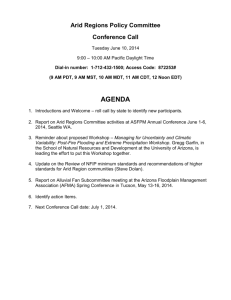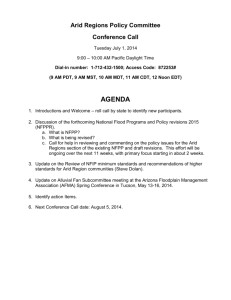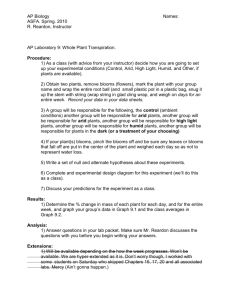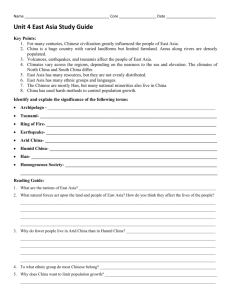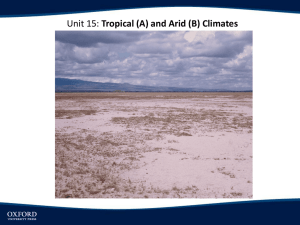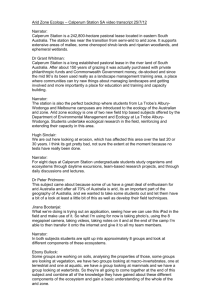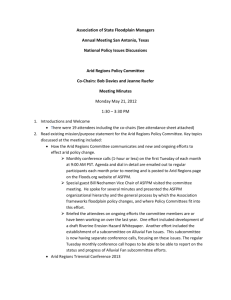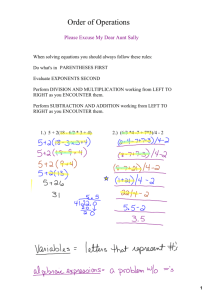.. (Gadus morhua) TURBULENCE-MODIFIED PROFILES OF FEEDING CONDITIONS FOR LARVAL COD
advertisement
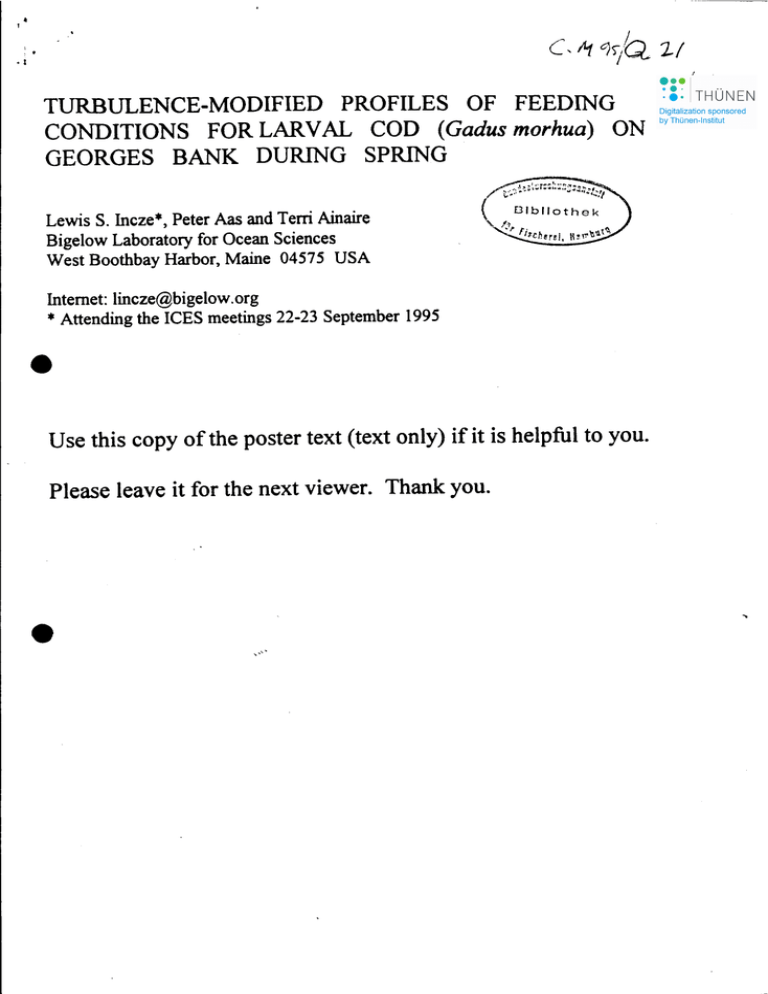
,•
..
•1
TURBULENCE-MODIFIED PROFILES OF FEEDING
CONDITIONS FOR LARVAL COD (Gadus morhua) ON
GEORGES BANK DURING SPRING
Lewis S. Incze*, Peter Aas and rem Ainaire
Bigelow Laboratory for Ocean Sciences
West Boothbay Harbor, Maine 04575 USA
Internet: lincze@bigelow.org
* Attending the leES meetings 22-23 September 1995
Use this copy ofthe poster text (text only) if it is helpful to you.
Please leave it for the next viewer. Thank you.
........
'.
METHOnS AND OBJECTIVES
The ,veitieaI distribution of eopepod nauplii (prey fhr early fee~g lärval eod,
Gcidus morhua) arid watt~r properties was sampled cit well-riiixed arid strcitified sites
011 Georges B~ usmg a pirinp~g system, CID and in vivo fltiorometer during a
fom-day period in late May 1992. Approximately 15 I was sailipled for nauplii at
diserete dept.hs. Data were eollected at fixed sites in
locations and
following a dritter diogÜed at 15m, which was Withiri the thennöCline dtiririg the
eruise (irregularities in some of the salinity data caused us to use the theniloeline aS
a proxy for the pycrioclme). Turbulence iri the upper mixed layer waS estirnated
from the 6-h average wind velocity prior to samplmg using a oouiidary layer model
(pond arid Pickäfd 1983), and were in elose agreement with empiricaI fits to datei
.,.(MacKerizie arid Leggeti 1993). Turbulence in the thermocline and in the bottom
~layer was taken from tUrbulence profiling (see Oakey 1988) eonducted oy Horne et
al. (In press) in the noIthel1l portion ofthe bank iri 1985 arid byN. Oakey arid D.
Hebert (UriiJubl. data) iri our study area (souihein Georges BäIik) Ü1 spring 1995.
A theoretlcal encoUnter rate (Gerritsen and Strlckler, 1977) was calculated for eod
larvae (0.52 crri SL) preying on copepod n~uplH (125 ~m TL) with arid wiiliout
tUrbulence (Rothschild arid Osborn 1988; Evans 1989). Details of the caleuhltiöris
are giveri by meze et al. (In press; please conteict the author).
"mous
This poster presents a seleetion of profiles from the study (Figure 1) to contrast
mixed vs. stiitifled areas änd to demonstrate the variety of prey distributions
possible iri s~ä.tified waters. We ask the question: "Does eonsideration of
tUrbulenee substantially alter the vertical profile of assurned feeding potential for
eod larvae?il We discuss öilr firidmgs arid stiggest that the firie-scale '{eitical
.patterns .?~.,enco,~~errates ~ t!te s~a~ifi~d re~~~ are,ass?c!ated with larger~scale
areas that may have "pateh;.ljke" dlßlenSlOns and eonsequenees for the feedmg
ecology of larvae.
'.
OBSERVATIONS AND DISCUSSION
Weil-mixed sites bad low concentrations ofnauplii, ca. 4101 , and showed little
variation of abunclance with depth. Stratified sites bad from 4-16 times the
integrated abundance of nauplii compared to weil-mixed sites and showed strong
vertical patterns of distribution. Maximum concentrations of nauplii, up to 160 I-I
(median = 32.5 101 )', were associated with the thennocline/fluoresecence maximum
at 7 of the 9 stratified sampling stations (median depth of sampled maximum = 15
m); at the remaining two stations the maximum was in the upper mixed layer.
Table 1 summarizes data from 11 propies and shows estimated encounter rates
based on some constant and simplifi.ed assumptions: larval swimming speed (v) =
0.2 cm sol; naupliar swimming speed (u) = 0.0125 cm sol; and encounter radius (R) =
0.26 cm (112 body length). Encounter is defined here as physical approach within a
spherical volume of the defined radius and is used for comparative purposes only -not for estimating actual detection or feeding rates which would require much more
detailed parameterization (see below).
Figure 2 shows profiles oftemperature and chlorophyll (1 m averaged) and naupliar
concentration (- 5 m resolution in the upper 20 in)~ Maximum water column depth
was 50 m at the mixed site (13P) and 70-83 m at the other three; thus, the deepest
sampIe is 20 m or more away from bottom. ~tegrated naupliar abundance down to
the deepest sampling depth is shown by ~~ Stations IIP and 24P show the greatest
and least stratification of nauplii, respectively. The naupliar maximum is associated
with the thermocline and fluorescence maximum in hoth cases (and at 25P and
others). 25P is added here to illustrate the greatest thermocline co~centration of
nauplii encountered during the cruise, although the integrated abundance is the same
as at 24 P.
The naupliar profiles at 11 arid 24P result in very different potential encounter rate.
profiles, shown in Figure 3. Here, encounter rate (e: from the concept of "contact"
rate) has been caIcuIated as number of prey per time assuming a constant radius artd
swimming behavior with no depth-related change. Note that encounter potential in
the thermoc1ine (shaded blue region) at 24P is ca. 1.5 x the value at I1P, and the
estimated rates are entirely different below the thermoc1ines at the two sites (24 P
»IIP). Under the assumptions employed here, turbulence increases encounter
rate by about 20% in the thennocline and 33% in the region sbown below it .
Turbulent kinetic energy dissipation rate used here (averaged from measurements) is
1 X 10 08 W kgo1 in the thennocline and 1 X 10 .0 Wkgo1 in the tidally mixed water
t
columit:> 20 in away from the frictional boimdäry. The larger total mcrease iri
encoUnter rate eDhancement dtie to tUrbulence in the mixed area is because of the
corribmed effectS of wind arid tide. The contrast between mixed and sttatified areas
is lessened by inchiding ttrrbillence, but absolute comparisons between the tWo must
await better parameterization of such things as swimming behavior, shape and ,
voluine ofthe perceptive field, feeding suc~ess vs. "encoUIlter".(as in the model),
and the effects of light arid turbulence itself. Satiatiori feeding levels rriay constraiii
iriteqjrehiiion of these differences because tUrbUlence can directly enhance feeding
only when static food concentrations are beIow sattiiation feeding levels.
The sensitivitY oftufbulence-modifled encounter rates to assumphons about v and R
is demonstriited in Figure 4, in which the value of each ofthe parameters is halved
independeriÜy. This is not meant to irriply the likely direction of change with fiirther
.nvestigatiöri, but only to show the magnitude.
Stations 11 and 25 (Figs. 2 arid 3) were sampled approximately 51 h apart at the site
of a current meter inooring (Fig. 1). Along-isobath westward drift dtiring this period
was roughly 19 krii at 45 m depth and 27 krii at 15 iri (Manning et 3.1. 1995). Thus,
there was verticaI shear in the water column arid withiri the populatiori of nauplii
(Acoustic Doppler Profiling will enable a higher resolution pictuie when the datei are
processed). The naupliar data set is too smaIl to examine the length scales of
variation with any rigor, hut suhstantial changes were seen at distances of 5;.30 lall
withiri tbe stratified area itself, based on drifter, mooring and transect sampIes.
Such spatial comple;dty must be included when evaluating the feecllng ecology of a
larVal yeai~claSs. Such consideratiori, arid an uriderständing of mechanisms
Unrlerlyirig the spatiaI patterns, will begin to link properties of the small-scale (the
.vertical; with tUrbUlence effects) to the intennediate-scale (water parcel, temporal
_hange, physical forcing) in order to estirilate impacts upon the population.
We häve not ciddresserl the tipper, wiricl-rillxecl layer.in this p~per because cod
hüvae are rare at thos'e depths in stratified areäs cif Georges Bank. Wind-induced
turbulence might playa fole.m other unportarit iriteractions, however, such aS
predatiori ori cod eggs (which are numerous in tli~ tipper Iayer), ~ weIl as paitiClepaiticle iriteraetioris arid feeding by numerous shallo:w-Iayer, neustonic and
pleustornc organisins (see Deiunan and Gargett 1995; Shimeta et aI. 1995).
